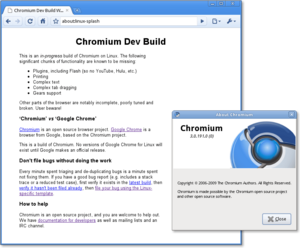Chromium (web browser) facts for kids
 |
|

|
|
| Original author(s) | |
|---|---|
| Developer(s) | The Chromium Projects, controlled by Google |
| Initial release | 2 September 2008 |
| Written in | C++ primarily, HTML, CSS, JavaScript for UI and test suite |
| Operating system |
|
| Platform | IA-32, x86-64, ARM, ARM64 |
| License | BSD-3 and others |
Chromium is a special kind of web browser project. It's like the main building blocks for many popular browsers, including Google Chrome, Microsoft Edge, and Opera. It's developed mostly by Google and is free and open-source. This means its code is available for anyone to see and use.
Contents
What is Chromium?
Chromium is the base code that many internet browsers use. Think of it as the engine and frame of a car. Different car companies can then add their own seats, paint, and features to make their unique car. In the same way, other companies take Chromium's code and add their own special features to create their browsers.
Open-Source and Free
Chromium is a free and open-source software project. This means:
- You can use it without paying.
- Anyone can look at its code.
- People can change and share the code.
Most of the code written by Google uses a special permission called the 3-clause BSD license. This license lets anyone build and share the browser using the Chromium name and logo. That's why many Linux distributions (types of computer operating systems) offer Chromium.
How is Chromium Different from Google Chrome?
Chromium provides most of the code for Google Chrome, but they are not exactly the same. There are some key differences.
Features Not in Chromium
Chromium does not have some features that Google Chrome has. These include:
- Automatic updates: Chromium doesn't update itself automatically. You usually need to update it manually.
- Google services: It doesn't have built-in connections to some Google services like browser sync.
- DRM module: It lacks a special module called Widevine, which helps play protected videos.
- Media formats: It doesn't include licensed ways to play popular video (H.264) and audio (AAC) formats.
- Tracking: It doesn't have the tracking tools that send usage and crash reports to Google.
Names and Branding
Google first named its browser "Chrome." They then named the open-source version "Chromium." This is because the metal chromium is used to make chrome plating, which is shiny.
Chrome looks and works like Chromium but has Google's colors and branding. Unlike Chromium, Chrome is not open-source. Its programs are given away for free under Google's own rules.
How Chromium is Developed
The Chromium browser code is very large, with millions of lines of code.
Who Works on Chromium?
Chromium has been a Google project since it started. Most of the work is done by Google employees. They use special email addresses that end with @chromium.org for this work. Google keeps strong control over the project.
Many other companies also help develop Chromium. Some of the most important contributors include Microsoft, Igalia, Yandex, Intel, Samsung, LG, Opera, Vivaldi, and Brave. Some employees from these companies also have @chromium.org email addresses.
How Chromium is Designed
Google designed Chromium to be the first browser that uses many separate processes. This means different parts of the browser (like each tab you open) run separately. This design helps the browser stay fast and secure, even with many tabs open. It also helps keep your computer safe by isolating different parts of websites.
Another important design choice was to make the browser's look very simple. This is called a minimalistic design.
The browser's engine, which is the part that displays web pages, was first based on Apple's WebKit. But Google changed it a lot over time. In 2013, Google officially created its own version called the Blink engine.
Programming Languages Used
The main programming language for Chromium is C++. This language is used for the core parts of the browser, like the Blink and V8 engines, how it handles internet connections, and most of its user interface.
Other parts of the user interface are made using HTML, CSS, and JavaScript. These are the languages used to build websites.
Chromium also uses other languages for specific tasks:
- Java and Kotlin for Android devices.
- Objective-C and Swift for iOS devices (like iPhones and iPads).
- Python for building the browser.
- Newer parts also use Rust.
Chromium's History
Early Years (2008-2010)
Google Chrome first came out in September 2008. At the same time, the Chromium code was also made available. This allowed people to build their own versions of the browser.
- Version 3 was the first version available for Linux computers. It added themes and made JavaScript faster.
- Version 6 made the browser look even simpler. It combined some buttons and hid the home button by default. It also added a built-in PDF reader and support for WebM videos.
- Version 7 made the browser much faster by using your computer's hardware better.
- Version 8 improved how Chromium worked with ChromeOS and added features like cloud printing.
- Version 9 added security features to protect against fake websites (phishing) and made the Adobe Flash plug-in safer. It also allowed access to the new Chrome Web Store.
Changes in 2011
In 2011, Google thought about big changes to how the browser looked, like combining the address bar and tabs into one line. However, they decided these changes were too risky and didn't do them.
Instead, they focused on making the browser smaller, better at handling web applications, and improving support for touch devices. A new button was added to let users log into multiple accounts at once. They also added tools to detect harmful software (malware).
By May 2011, Chromium was already becoming smaller in size. Other updates in 2011 included making graphics faster on all pages and adding support for new web audio features.
Recent Updates (Since 2012)
- In 2012, Chromium added a new way for web applications to use your webcam and microphone (after asking your permission).
- In 2013, Chromium's modified WebKit engine officially became the Blink engine.
- Later in 2013, new features included the ability to reset user profiles and new tools for browser extensions. Tabs also started showing if they were using audio or your webcam.
- Version 67 improved security by isolating each website in its own process.
- Version 69 introduced a new look for the browser.
- Since 2021, Chromium builds can no longer use the Google Chrome sync service.
- Starting with version 89, Chromium only works on newer Intel and AMD processors.
- As of version 110, Windows users need Windows 10 or a newer version to run Chromium.
Browsers Based on Chromium
Many other browsers are built using the Chromium code. Some are owned by companies (proprietary), and some are also free and open-source.
Browsers Owned by Companies
- Arc
- Amazon Silk
- Avast
- Comodo Dragon
- DuckDuckGo
- Ecosia
- Epic
- Huawei
- Maxthon
- Microsoft Edge
- Naver Whale
- NetFront
- Opera
- Puffin
- Samsung Internet
- Sleipnir
- SRWare Iron
- UC Browser
- Vivaldi
Some are mainly used in specific countries:
- 360 and QQ (for China)
- Cốc Cốc (for Vietnam)
- Yandex (for Russia)
Free and Open-Source Browsers
- Brave
- Dooble
- Falkon
- Otter
- qutebrowser
- Supermium
- ungoogled-chromium
Chromium in Other Apps
Chromium's web browser parts are also used inside other computer programs. These are called app frameworks. They let developers build apps using web technologies like HTML and JavaScript. This means the apps can work on many different operating systems.
Some examples of these frameworks are:
- Chromium Embedded Framework
- Electron
- NW.js
- Qt WebEngine
There are also special components like Android System WebView and Microsoft Edge WebView2. These allow apps to show web content easily. Many popular apps today, like Spotify and Slack, are built using these methods.
See also
 In Spanish: Chromium (navegador) para niños
In Spanish: Chromium (navegador) para niños



